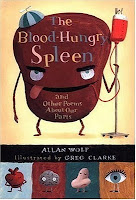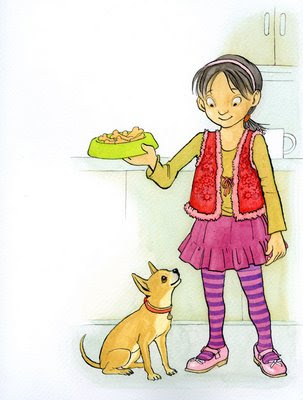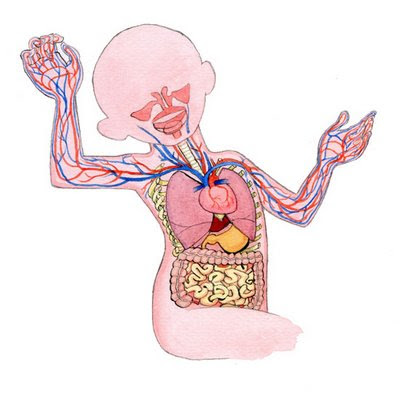I enjoyed teaching about the human body when I was teaching middle school science. It's not always the easiest subject to share with kids, but it sure is interesting. Wherever possible I tried to make ideas concrete. For example, when I taught about blood I brought in three 2-liter bottles, two filled to the brim and one half-filled with red colored water. Then I handed them to a student to carry around. This represents about how much blood the average adult has in his/her body (~5 liters)!
Unfortunately, the human body is not part of the science curriculum in Virginia. It is taught as part of the health and physical education curriculum. While my teacher friends in Virginia might not appreciate today's pairing, there are plenty of teachers in other states who teach about body systems.
Today's book trio covers a wide range of ideas regarding the human body.
Poetry Book
 The Blood-Hungry Spleen and Other Poems About Our Parts
The Blood-Hungry Spleen and Other Poems About Our Parts, written by Allan Wolf and illustrated by Greg Clarke, is a book of 35 poems that celebrates our gross, disgusting, fascinating, and amazing body parts and functions. It begins with a poem entitled "Our Amazing Body Language" and is followed by anatomically devoted sections with one or more poems. Sections (with number of poems in parentheses) include:
- That's You All Over (1)
- On the Face of It (7)
- Parts that Bend (4)
- A Bone (or Two) to Pick with You (2)
- Belly Buttons and Bottoms (2)
- The Circulation Department (3)
- A Breath of Fresh Air (1)
- Muscle Matters (2)
- The Control Center (3)
- The Ins and Outs of Eating (5)
- Body Chemistry (1)
- The Production Department (3)
If you're a fan of
Wallace Stevens, you'll be thrilled with the poem "Thirteen Ways of Looking at Your Knees and Elbows." No, seriously. Here's an excerpt.
IV
The knee wears a cap
all year long,
even in church.
V
If elbows did not bend
you could not scratch
your nose.
VI
If knees did not bend
there would be no
marriage proposals.
VII
Elbows and hair bows
do not look alike
VII
When two knees meet
they say, "I love you.
I want you. I kneed you."
The poems are funny and sometimes silly, but still ultimately impart some real knowledge about the part under consideration. Here's an excerpt from one of the bone poems.
Bone Chart
Your bones hold you up like the frame of a house.
Be you boy. Be you girl. Be you lion or mouse.
Your skull is a bone that encloses your brain.
It holds up your hat, and it keeps out the rain.
Just under your skull is the trusty jawbone.
It helps you to chew and to talk on the phone.
Your neck bones and back bones are called vertebrae.
They help keep your spinal cord out of harm's way.
...
Poems © Allan Wolf. All rights reserved.The illustrations are whimsical (many of the organs depicted have faces and arms and legs) and not necessarily anatomically correct, but they do convey the messages shared in the poems. For example, the illustration that accompanies the poem "Your Muscles Keep You Moving" depicts a sleeping girl with inset pictures of her heart and stomach sweating while running on treadmills.
There is no back matter here, but it isn't really needed. Once Wolf has piqued his readers' interest, they'll be sure to look for more information on their own, especially after they've read a poem entitled "Spit" or "Consider the Anus."
Nonfiction Picture Book50 Body Questions: A Book That Spills Its Guts, written by Tanya Lloyd Kyi and illustrated by Ross Kinnaird, is a question and answer book that tackles all kinds of topics related to the human body. Organized into 7 chapters, the book opens with an informative introduction ("Welcome to the Body Shop") and closes with a thoughtful conclusion ("High-Tech Humans"). In between the chapters are organized around related organs and systems.
Here's an excerpt from the introduction.
Blink. Your body just created thousands of cells. Snap. Thousands more!
Every single day, you make billions of new cells and get rid of just as many old ones. You couldn't possible flutter your eyelashes or snap your fingers as fast as those cells are produced.
Inside each microscopic building block is the exact same genetic information—a specific code that makes you unique. There are seven billion people in the world, but no one else has your code. Your cells create a body that's different from any other. Different . . . and yet similar.
Every chapter begins with and ends with additional information about the topic. Chapters include: That Takes Guts, Blood Ties, Form and Function, Armed Invaders, Sense and Feeling, Gray Matters, and How Shocking!. Some of the questions readers will find answers to include:
- Are there aliens inside you?
- Is blood thicker than water?
- Is your brain on a sugar high?
- How is your spine like a racetrack?
Text © Tanya Lloyd Kyi. All rights reserved.The illustrations are entertaining and the text is throughly engrossing (no pun intended). Readers of all ages will learn something new and find much to appreciate here. Back matter includes a helpful glossary, further reading, selected sources, and an extensive index.
Perfect Together
I can't imagine a more perfect match for Wolf's poems than the thoroughly asked and answered questions in Lloyd Kyi's book. Start with a poem and see what questions it leads you to explore!
For additional resources, consider these sites.
By Jonathan Crowe
Each day of our lives is a battle for survival against an army of invaders so vast in size that it outnumbers the human population hugely. Yet, despite its vastness, this army is an invisible threat, each individual so small that it cannot be seen with the naked eye. These are the microbes – among them the bacteria and viruses – that surround us every day, and could in one way or another kill us were it not for our immune system, an ingenious defence mechanism that protects us from these invisible foes.


Shields, Amy. 2011.
Little Kids' First Big Book of Why.Washington, DC: National Geographic.
A fun book for several reasons, the
First Big Book of Why asks many of the great questions that occur to children, but grownups never ponder. "Why can I see myself in a mirror?" "Why do the stairs seem to disappear on an escalator?" "Why does the moon change shape?"
In addition, it's a great title to booktalk or share on school visits. Just read a few pages and kids will want to know more.
And, it's a great browsing book. Just leave it out and someone will find something interesting inside.
The questions are highlighted by large font in colored text boxes and the pages are brightly colored with photos of kids and the things which keep them wondering. The answers are short and sweet with bold font for the most important points,
Why does Grandma have wrinkles?
Skin grows and stretches as you grow from baby size to adult. When you've been an adult for a while, skin stops growing and stretching. It gets a little tired and a little less elastic.
The lines you make when you smile today are where your wrinkles will be when you are old. A lifetime of laughter helps your skin wrinkle very nicely.
Nicely put!
Although this is a great browsing book, it is divided into four themed chapters, Amazing Me, How Things Work, Animals All Around and Wonders of the World. In addition to the questions and answers, there are scattered text boxes and insets with interesting facts and experiments.
Little Kids' First Big Book of Why has a Table of Contents, a Glossary (albeit a very small one), Parent Tips, and Additional Resources.
Want to know why doughnuts have holes and why your toes get wrinkly in the tub? You'll have to read it to find out! Nonfiction fun for lower elementary school grades.

Yes, it's
Nonfiction Monday again and today's roundup is at
proseandkahn.
This is the second post in our latest regular OUPblog column: SciWhys. Every month OUP editor and author Jonathan Crowe will be answering your science questions. Got a burning question about science that you’d like answered? Just email it to us, and Jonathan will answer what he can. Today: What are genes and genomes?
By Jonathan Crowe
I described in my last blog post how DNA acts as a store of biological information – information that serves as a set of instructions that direct our growth and function. Indeed, we could consider DNA to be the biological equivalent of a library – another repository of information with which we’re all probably much more familiar. The information we find in a library isn’t present in one huge tome, however. Rather, it is divided into discrete packages of information – namely books. And so it is with DNA: the biological information it stores isn’t captured in a single, huge molecule, but is divided into separate entities called chromosomes – the biological equivalent of individual books in a library.
I commented previously that DNA is composed of a long chain of four building blocks, A, C, G, and T. Rather than existing as an extended chain (like a stretched out length of rope), the DNA in a chromosome is tightly packaged. In fact, if stretched out (like our piece of rope), the DNA in a single chromosome would be around 2-8 cm long. Yet a typical chromosome is just 0.00002–0.002 cm long: that’s between 1000 and 100,000 times shorter than the unpackaged DNA would be. This packaging is quite the feat of space-saving efficiency.
Let’s return to our imaginary library of books. The information in a book isn’t presented as one long uninterrupted sequence of words. Rather, the information is divided into chapters. When we want to find out something from a book – to extract some specific information from it – we don’t read the whole thing cover-to-cover. Instead, we may just read a single chapter. In a fortuitous extension of our analogy, the same is true of information retrieval from chromosomes. The information captured in a single chromosome is stored in discrete ‘chunks’ (just as a book is divided into chapters), and these chunks can be read separately from one another. These ‘chunks’ – these discrete units of information – are what we call ‘genes’. In essence, one gene contains one snippet of biological information.
I’ve just likened chromosomes to books in a library. But is there a biological equivalent of the library itself? Well, yes, there is. Virtually every cell in the human body (with specific exceptions) contains 46 chromosomes – 23 from each of its parents. All of the genes found in this ‘library’ of chromosomes are collectively termed the ‘genome’. Put another way, a genome is a collection of all the genes found in a particular organism.
Different organisms have different-sized genomes. For example, the human genome comprises around 20,000-25,000 genes; the mouse genome, with 40 chromosomes, comprises a similar number of individual genes. However, the bacterium H. influenzae has just a single chromosome, containing around 1700 genes.
It is not just the number of genes (and chromosomes) in the genome that varies between organisms: the long stretches of DNA making up the genomes of different organisms have different sequences (and so store different information). These differences make sense, particularly if we imagine the genome of an organism to represent the ‘recipe’ for that organism: a human is quite a different organism from a mouse, so we would expect the instructions that direct the growth and function of the two organisms to differ.
B
 The Blood-Hungry Spleen and Other Poems About Our Parts, written by Allan Wolf and illustrated by Greg Clarke, is a book of 35 poems that celebrates our gross, disgusting, fascinating, and amazing body parts and functions. It begins with a poem entitled "Our Amazing Body Language" and is followed by anatomically devoted sections with one or more poems. Sections (with number of poems in parentheses) include:
The Blood-Hungry Spleen and Other Poems About Our Parts, written by Allan Wolf and illustrated by Greg Clarke, is a book of 35 poems that celebrates our gross, disgusting, fascinating, and amazing body parts and functions. It begins with a poem entitled "Our Amazing Body Language" and is followed by anatomically devoted sections with one or more poems. Sections (with number of poems in parentheses) include:













I love the one showing muscles. It looks like a very nice approach for this kind of book - detail with a light touch.
So well done, so "Shelley" and so colorful..but a little bit scary when you lift the flap.